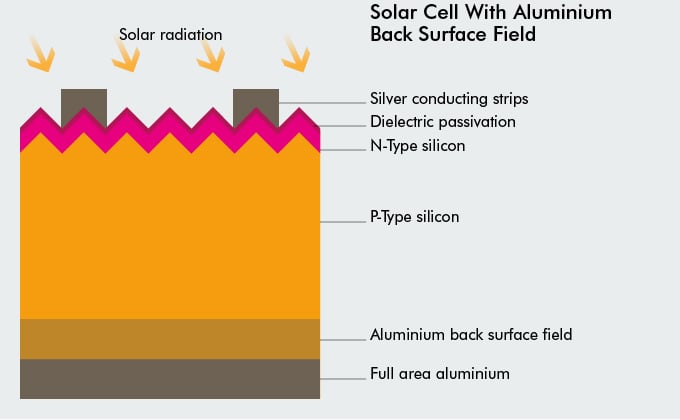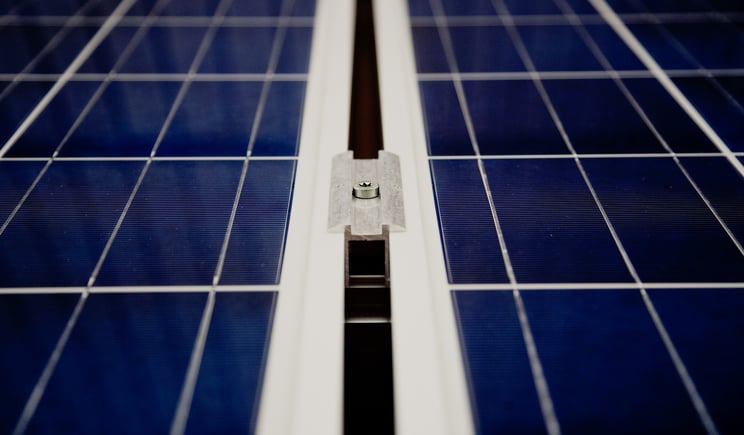What is a PERC cell?
PERC solar cells are a variation on the traditional cells used in solar panels that offer enhanced efficiency. The acronym PERC stands for Passivated Emitter and Rear Contact or Passivated Emitter and Rear Cell. Over the last few years they have become more and more popular, to the point where they now make up over 40% of the solar technology market and are expected to dominate by 2021, according to the ITRPV.
The perks of PERC and high efficiency panels
The main benefit of higher efficiency cells, such as PERC, means panels can generate more electricity from the same space. So manufacturers can offer panels rated at a higher output, without having to increase the physical dimensions. This is particularly useful when you only have a small roof area suitable for solar, as it allows you to offset more of your demand. Or if your roof has gaps too tight for traditional panels, you may be able to make use of them with smaller, higher efficiency modules.
Comparison with regular panels
As an example, let’s say you need to fit 10kWp on a new build property. How would PERC stack up against regular polycrystalline panels?
|
10kWp system |
Standard polycrystalline |
PERC |
|
Output per panel |
275W |
300W |
|
Number of panels required |
37 | 34 |
|
Roof area required |
61m2 | 56m2 |
|
Cost |
£8000 |
£8500 |
|
Lifetime output |
206,044kWh | 212,288kWh |
|
Lifetime cost per kWh |
3.9p | 4.0p |
|
Colour |
Blue cell with white backsheet and silver frame |
Black cell with black backsheet and black frame |
As you can see, PERC panels with the same dimensions can generate more power, meaning fewer panels are required. While the overall system is more expensive, lifetime cost per kWh produced balances out.
Assumptions:
Panels installed parallel to roof.
Panel area: 1.64m2 (both same size - allows for some spacing between modules).
Cost: PERC £50/kW more expensive.
Lifetime output: assumes 900 kWh/kW generation, 25 year lifetime. Accounts for linear panel degradation (275W polycrystalline panel degrades to ~80% at 25 years, vs ~85% for monocrystalline PERC).
Brands and sample datasheets
Here are a few example datasheets from the top manufacturers of solar modules utilising PERC technology:
- Longi Solar - Longi 300W All Black Mono
- Trina Solar - HoneyM Plus
- Q Cells - Q.PEAK DUO-65
Learn more
If you’d like to find out more about using PERC solar modules in your project, get in touch with us today on 0118 951 4490. You may also like to download our specifier's guide to PV:
And if you’d like to dive into the more technical side of the technology, read on...
PERC solar cell structure
A solar cell works by sunlight inducing a flow of electrons across a silicon layer to metal contacts at the front and rear (for more detail see our page on how solar PV works). Here’s a diagram of the structure of a standard solar cell:

With a PERC cell, the full area aluminium back contact is replaced with a dielectric passivation layer, dielectrically displaced mirror and individual aluminium contacts. Passivation requires a layer of oxidised material. Holes are lasered in this layer so metal contacts can penetrate to reach the silicon.
_LOW.jpg?width=680&name=Solar_Cell_(PERC)_LOW.jpg)
PERC solar cell efficiency
So how does this structure result in an increase in efficiency? There are three main reasons:
- The passivation layer helps keep electrons flowing, as they would otherwise recombine with atoms on the metal contacts, lowering the voltage and reducing output.
- The reflective rear surface gives unabsorbed light a second chance to be absorbed as it bounces back through the cell.
- The passivation layer absorbs less heat than the back surface of a regular cell, reflecting the heat-inducing wavelengths and keeping the cell cooler (which results in a higher efficiency).
History of PERC development
PERC technology has been around for a long time, at least theoretically. It was first developed at the University of New South Wales during the 1980s. So why has it only recently gained mass popularity? Standard solar cells have a relatively simple (and therefore cheap) production process, involving the aluminium back contact being screenprinted in place. In contrast, PERC cells are a bit more complex, with the added passivation layer, which needs to be cut for the contacts.
While the theory had always existed, it took much longer for the technology to become scalable and economically viable. The market has come on so much in the last decade, that nowadays most manufacturers are producing PERC solar panels.










